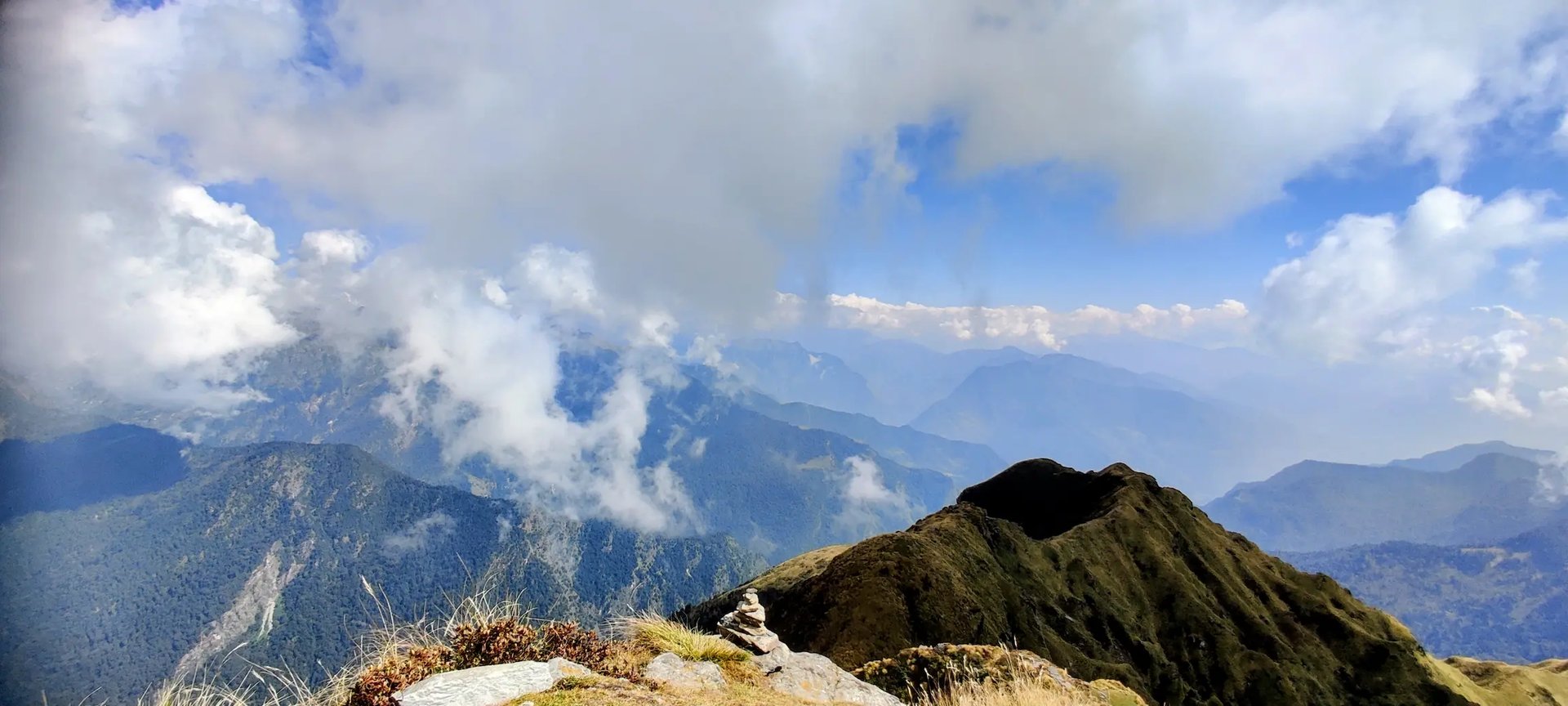
Chopta–Tungnath–Chandrashila: Scenic Himalayan Trek
A soul-stirring Himalayan trek through Chopta, Tungnath, and Chandrashila.
Updated on: 25th, Oct 2025
Explored on: Oct' 2021
Chopta–Tungnath Trek: Himalayan Serenity & Spiritual Views
If you’re seeking a short trek in the Himalayas that blends calm, adventure, and spirituality, the Chopta to Tungnath Trek is a perfect escape. Tucked in Uttarakhand’s Garhwal region, the Land of Gods, this trail leads to Tungnath, the Highest Shiva Temple in the World, perched at 12,100 feet. True to its name — Lord of the Peaks — Tungnath offers a rare harmony of devotion, natural beauty, and quiet strength.
The journey begins in the serene meadows of Chopta, winding through pine forests and gentle trails that open to breathtaking Himalayan vistas. As you climb higher, the air feels still and sacred, carrying whispers of ancient legends of the Panch Kedar temples. At Tungnath, the panorama of Nanda Devi, Trishul, and Chaukhamba peaks lingers long in memory, a scene where nature and spirituality meet.
For those eager to explore further, the trail stretches to Chandrashila Summit, offering a 360-degree view of snow-clad ranges, and Deoriatal, a pristine lake reflecting the mighty Himalayas. Together, the Chopta–Tungnath–Chandrashila–Deoriatal circuit stands as one of Uttarakhand’s most cherished short treks — a seamless journey of peace, legend, and wonder. Whether you seek solitude, adventure, or a spiritual connection, this trek leaves an imprint that stays with your soul.
Table of Contents
How to Reach Tungnath: Your Gateway to the Garhwal Himalayas
Every journey to Tungnath begins with a pause at Rishikesh, the spiritual gateway to the Himalayas. No matter how you arrive — by air, train, or road — Rishikesh becomes your base before the ascent toward Chopta. From here, winding mountain roads draw you into pine forests, river valleys, and the silent call of the peaks. It’s wise to keep two buffer days — one for the scenic drive from Rishikesh to Chopta, and another for the return, letting the journey breathe as much as the destination.
By Air:
The nearest airport is Jolly Grant Airport, Dehradun, about 20 km from Rishikesh. Taxis and shared cabs make the short ride in roughly 40–45 minutes. From here, the plains fade behind you, and the mountain road begins, leading to the meadows and forests of Chopta.
By Train:
Rishikesh has two stations: Rishikesh railway station (RKSH) within the city and Yog Nagari Rishikesh (YNRK) a little west on the new rail line. The nearest major station is Haridwar Junction, around 25 km away, well-connected to Delhi, Mumbai, Kolkata, and other cities. From the station, taxis or buses carry you along the scenic route to Chopta, with river views and hill bends teasing the Himalayas ahead.
By Road:
Rishikesh is well-linked to Delhi and other North Indian cities by road. You can self-drive, hire a cab, or take a bus from Delhi (approx. 6–7 hours). After Haridwar, the highway follows the emerald flow of the Ganga, a gentle prelude to the mountains. Beyond Rishikesh, the real adventure begins — the road to Chopta winds through Devprayag, Rudraprayag, and Ukhimath, offering cascading rivers, forested slopes, and mountain curves at every turn. The drive takes around 7–8 hours, but every bend feels like a step closer to Himalayan stillness.
Take your time, breathe in the mountain air, and let the journey unfold naturally. The road to Tungnath and Chopta isn’t just travel — it’s the first taste of the quiet, sacred world waiting at the peaks.
Best Time to Visit Tungnath: Perfect Seasons for Himalayan Views
Timing your trek to Tungnath shapes the entire experience — whether you seek peace, adventure, or the simple joy of crisp mountain air. The best months for the Chopta Tungnath Chandrashila trek are April to June and September to November, when the Himalayas greet you with clear skies, gentle winds, and trails made for wandering souls.
Spring & Summer (April – June):
Mild temperatures of 10–20°C, blooming rhododendrons, and mostly clear trails make this season perfect for beginners, families, and nature lovers. The meadows of Chopta glow in spring’s colors, while the path to Tungnath and Chandrashila offers panoramic views that feel endless.
Autumn (September – November):
Post-monsoon freshness, vibrant meadows, and unobstructed Himalayan vistas make autumn ideal for photographers, solitude seekers, and anyone wanting a quiet escape. The crisp air sharpens every peak, from Nanda Devi to Trishul, leaving memories that linger long after the trek ends.
Winter (December – March):
During winter, Tungnath Temple remains closed, and Chopta transforms into a snow-draped wonderland. This season is for experienced trekkers, fully equipped for icy trails and frosty adventures.
Monsoon (July – August):
Heavy rains make trails slippery, and landslides are common, so trekking is risky. It’s better to wait for the skies to clear and the mountains to shine again.
Each season at Tungnath, Chopta, and Chandrashila has its own rhythm — spring’s bloom, autumn’s clarity, winter’s calm — yet no matter when you visit, the Himalayan peaks and Deoriatal lake meet you with quiet grace and timeless beauty.
Where to Stay Near Tungnath: Cozy Stays Amid Himalayan Meadows
Finding the right place to stay can make your Chopta Tungnath Chandrashila trek even more memorable. Chopta, the tranquil hamlet at the base of the trail, offers a range of options for every traveler — solo adventurer, couple, family, or group. Staying here keeps you close to the trekking path while immersing you in the peace and serenity of the Garhwal Himalayas.
Premium & Heritage Stays:
For travelers seeking luxury or heritage charm, Chopta Resort perches amid vast alpine meadows beside a gentle stream, offering comfort with breathtaking mountain views. Cafe Buransh, with its panoramic vistas and proximity to key trekking and pilgrimage routes, is ideal for soaking in Uttarakhand’s natural beauty while relaxing before or after your trek.
Mid-Range Comforts:
If you want a balance of comfort and mountain charm, Chopta Mount Holiday Camp & Resort offers clean Swiss-style camps with a family-friendly atmosphere. Humming Bird by Aaryam, nestled in Chopta’s quiet beauty, is perfect for a peaceful mountain escape, providing a restful base before ascending to Tungnath, Chandrashila, or Deoriatal.
Budget Options:
Budget-conscious travelers can opt for homestays in Sari Village or Chopta Village, giving an authentic local experience at the base of the trek. Dormitory-style rooms or shared tents with basic facilities let you enjoy the mountains without stretching your wallet.
Many travelers booking a Chopta Tungnath tour package from Delhi or Rishikesh find that accommodations are included — from cozy guesthouses and homestays to eco-camps tucked into forests. No matter your choice, Chopta and Sari Village stays let you rest, recharge, and embrace the Himalayan adventure, setting the perfect tone for your journey to Tungnath, Chandrashila, and Deoriatal lake.


Nested in Garhwal's quiet peaks,
Tungnath calls where devotion speaks.
Chopta meadows, pine-scented trails,
Whispers of legends ride the gales.
Pandavas chased the bull of Shiva,
Limbs appeared — Tungnath’s sacred diva.
Chandrashila, Moon Rock in the sky,
Sunrise greets the peaks standing high.
Deoria Tal mirrors Himalayan dreams,
Emerald waters, snow-capped gleams.
Dhari Devi guards the hills and streams,
A goddess watching over sacred seams.
Tracing the path unknown, we stride,
The roaming rhyme flows like a tide.
Each trail whispers secrets of old,
Mountains, temples, and tales unfold.
The Tungnath Chandrashila Trek, along with Deoriatal, is a journey that blends adventure, nature, and spirituality. From the tranquil meadows of Chopta to the sacred Tungnath Temple and the panoramic Chandrashila Summit, every step offers breathtaking Himalayan vistas, serene forests, and whispers of ancient legends. It’s one of Uttarakhand’s most scenic short treks, perfect for those seeking both thrill and calm.
To truly enjoy this experience, plan for a minimum of 3 days. If you prefer a relaxed pace, consider 4 days to soak in the mountains fully. A typical itinerary could look like this:
Day 0: Journey from Rishikesh to Chopta, winding through scenic rivers and mountains.
Day 1: Trek from Chopta to Tungnath, continuing to Chandrashila Summit, and return to Chopta or nearby accommodation.
Day 2: Deoria Tal trek, followed by your return journey to Rishikesh.
This plan lets you experience the magic of Chopta, Tungnath, Chandrashila, and Deoria Tal without rushing, tracing the path unknown, and following the roaming rhyme of the Garhwal Himalayas.
Planning Your Trip: Tungnath, Chandrashila, and Deoria Tal Trek Itinerary
Day 0 – Journey to Chopta
Begin your Himalayan adventure with a scenic drive from Rishikesh to Chopta, which takes around 7–8 hours. The road is generally good, though occasional landslides remind you of the mountains’ wild charm. Pause at Devprayag, where the holy Alaknanda and Bhagirathi rivers meet, forming the sacred Ganga, and soak in the spiritual aura. A little further along is Rudraprayag, the confluence of Alaknanda and Mandakini rivers, flanked by lush hills and temples that echo centuries of devotion. On the way, pass through Ukhimath, a tranquil town known for its ancient temples and spiritual traditions. During winter months, the idols from Kedarnath and Madhyamaheshwar Temples are brought here and worshipped for six months, adding a unique sacred charm to the town. Each stop is a step closer to the peaceful meadows of Chopta and the start of your trek.
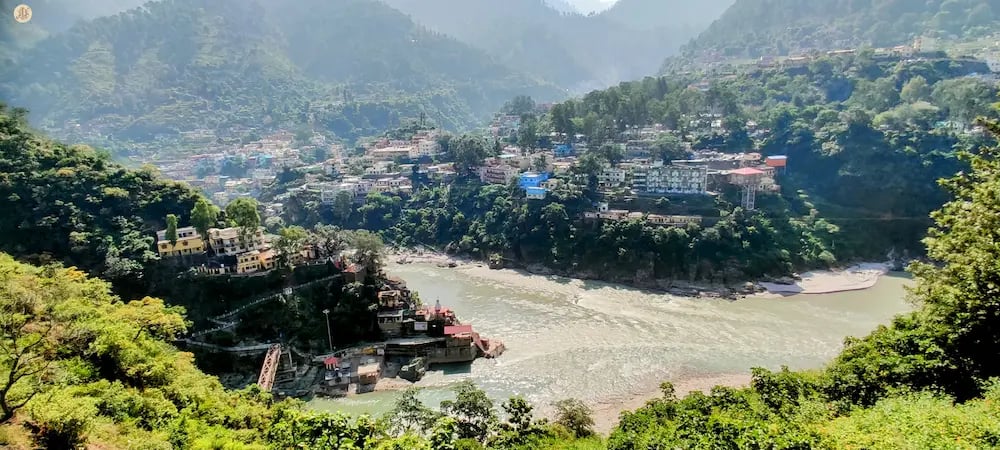

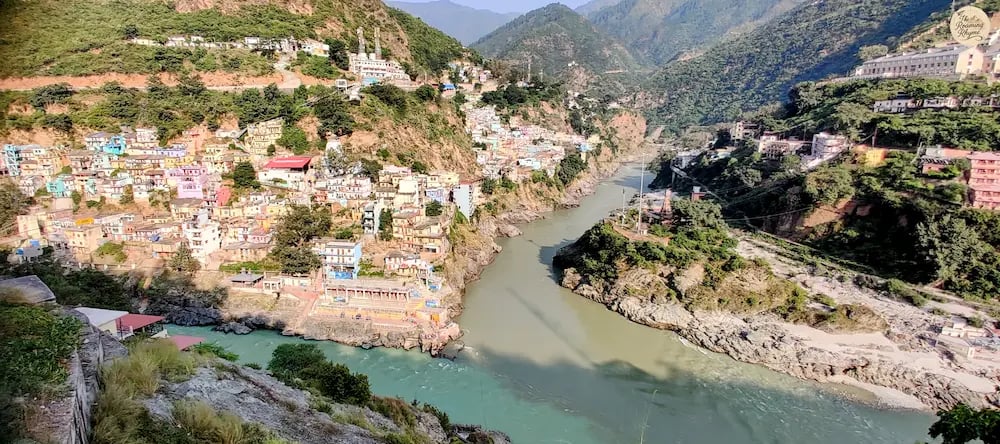

Rudraprayag: Where Alaknanda Meets Mandakini in Himalayan Grace
Devprayag: Where Alaknanda and Bhagirathi Merge in Sacred Harmony
Day 1 – Tungnath & Chandrashila Trek
Start early from Chopta and ascend through alpine meadows and rhododendron forests to reach the sacred Tungnath Temple, the world’s highest Shiva shrine, steeped in Pandava legends. Continue to the Chandrashila Summit, where 360-degree Himalayan panoramas and the crisp mountain air reward every step, making the trek a blend of nature, spirituality, and adventure.
Trek to Tungnath: Nature, Meadows, and Mountain Views
The Tungnath trek blends adventure with the serene beauty of the Garhwal Himalayas.. From here, the trail winds about 3.5 km to Tungnath Temple, passing a check post at the Kedarnath Wildlife Sanctuary (entry fee ₹200, opens at 8 AM) — the official gateway to your Himalayan adventure.
The path is moderate and beginner-friendly, wide enough for easy walking, with well-paved stone steps guiding the way. Signboards remind trekkers to stay on the marked trail — shortcuts are steep, risky, and carry fines up to ₹25,000. Along the climb, there are plenty of spots to pause, photograph, or simply breathe in the crisp mountain air.
As you ascend, the landscape transforms with every step. Alpine meadows unfold like colorful carpets, dotted with spring and summer wildflowers such as primroses, irises, and edelweiss. The trail winds through rhododendron forests, where clusters of red, pink, and white blossoms perfume the air, and towering oak and deodar trees offer shade and quiet reflection.
Beyond the forests, the Himalayan panorama opens up. Snow-capped peaks like Nanda Devi, Trishul, Chaukhamba, and Kedarnath dominate the skyline, while wildlife enthusiasts may spot the vibrant Himalayan Monal, musk deer, or other sanctuary residents.
Most trekkers complete the climb to Tungnath Temple in 2–3 hours one way, but the real reward lies in the pauses — soaking in the alpine blooms, the whispering forests, and the majestic peaks that make the Chopta to Tungnath trek an unforgettable Himalayan journey.

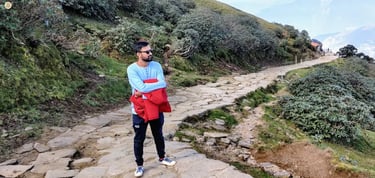
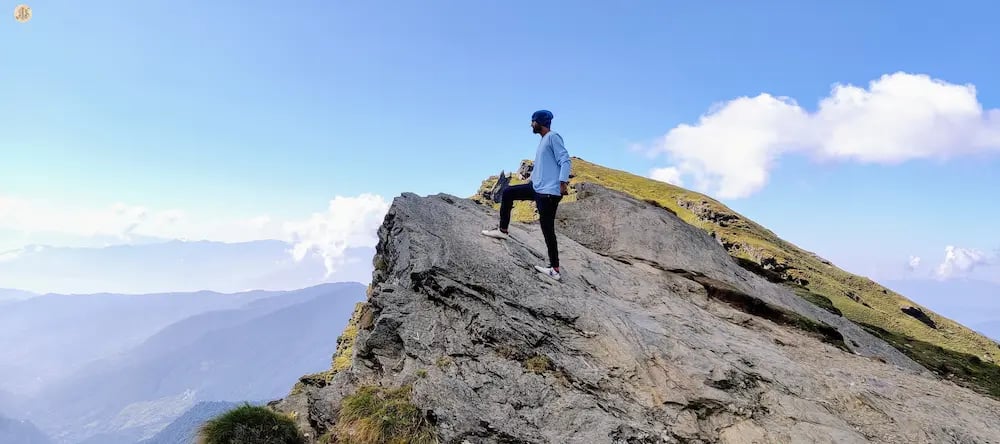

Tungnath Trail: Walking Amid Meadows and Himalayan Peaks
Tungnath-Chandrashila Trek: Standing Atop Majestic Himalayan Heights
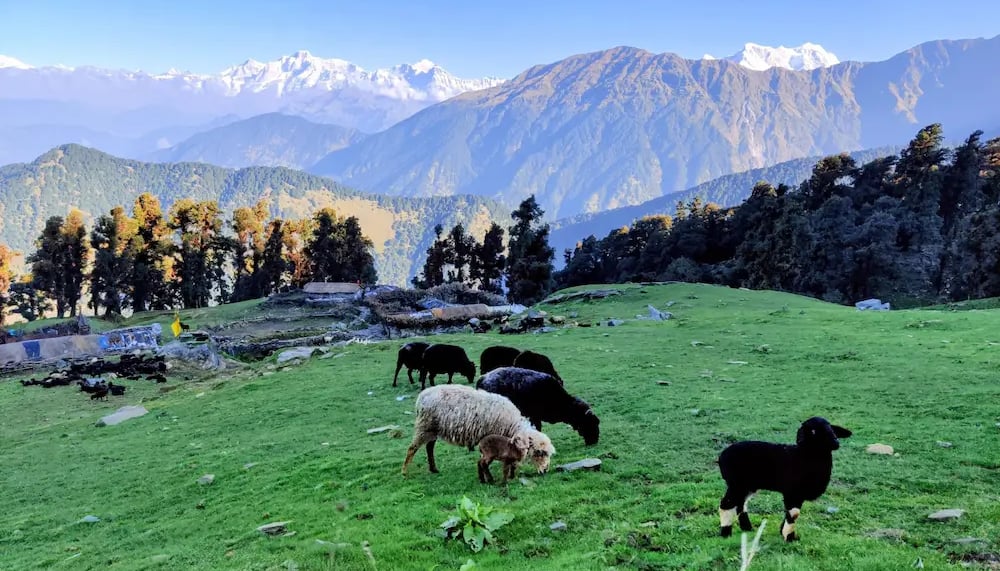

Chopta Meadows: Gentle Himalayan Sheep Amid Alpine Beauty
Tungnath Temple: A Spiritual Haven Amid Himalayan Peaks
Perched at 3,680 meters, Tungnath Temple stands as the world’s highest Shiva temple, drawing pilgrims, trekkers, and nature lovers alike. Open from late April or early May until November, it is a beacon of devotion amidst the serenity of the Garhwal Himalayas. The temple’s stone walls showcase intricate carvings of deities and mythological tales, while the wooden interiors reflect the craftsmanship of local artisans. Its pagoda-style roof, simple yet majestic, rises gracefully against the backdrop of snow-capped Himalayan peaks, blending seamlessly with the mountains around.
The temple isn’t alone in its solitude. Small shrines and prayer spots dedicated to Lord Ganesh, Parvati, and other deities dot the area, offering spaces for meditation and quiet reflection. The rhythmic chants of prayers, the gentle ringing of temple bells, and the distant whisper of wind through deodar and oak forests create an atmosphere of profound calm.
Surrounded by rolling alpine meadows and vibrant wildflowers during spring and summer, Tungnath provides panoramic views of giants like Nanda Devi, Trishul, and Chaukhamba Peaks. The crisp, high-altitude breeze invigorates body and soul, while the serene surroundings invite contemplation and spiritual connection. Even brief moments here — watching clouds drift across peaks or listening to soft prayers — leave a lasting impression, making Tungnath Temple not just a destination, but a profound encounter with Himalayan divinity.
Tungnath Tranquility: Finding Peace Amid Himalayan Peaks
Tungnath Temple: Sacred Peaks and Whispering Shrines
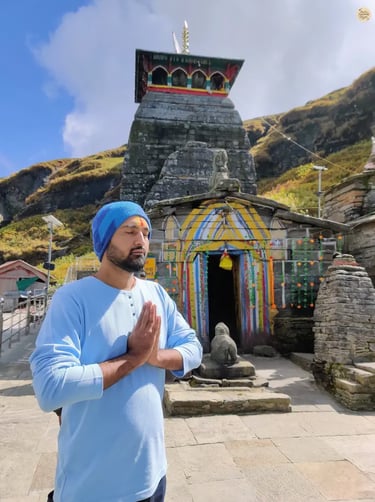

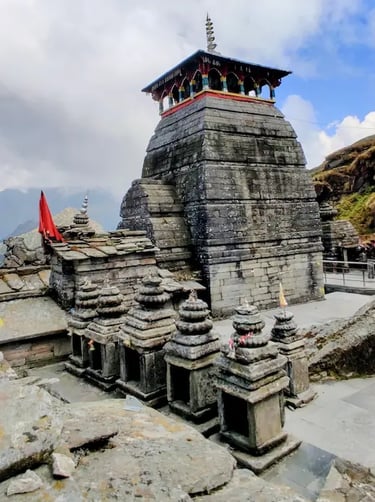

Tungnath Temple Story: Pandavas, Shiva, and Spiritual Tales
Tungnath Temple is steeped in Himalayan history and mythology, its story woven deep into the epic Mahabharata. After the 18-day Kurukshetra war, the victorious Pandavas were filled with sorrow and guilt over the deaths of their kin. Seeking atonement and forgiveness, they turned to Lord Shiva, the supreme arbiter of justice, knowing only he could relieve their grief.
Shiva, however, did not appear directly. To test their devotion, he took the form of a bull and fled into the Himalayan mountains, hiding from the Pandavas. Determined, the Pandavas chased the bull across rugged peaks until it disintegrated into five sacred sites, forming the Panch Kedar temples:
Kedarnath – the hump appeared here.
Tungnath – the limbs manifested at this spot.
Rudranath – the face emerged here.
Madhyamaheshwar – the navel and stomach surfaced here.
Kalpeshwar – the hair appeared at this location.
Tungnath, where Lord Shiva’s limbs appeared, became a site of immense spiritual significance. The Pandavas built the temple here, offering prayers and rituals to seek peace and redemption. Over centuries, Tungnath grew beyond a pilgrimage destination, becoming a symbol of devotion, introspection, and spiritual connection in the Garhwal Himalayas.
Even today, visitors to Tungnath feel the ancient aura of penance and divine presence. The rhythmic temple bells, gentle chants, and towering Himalayan peaks evoke timeless spirituality, reminding trekkers that the path to Tungnath is not just a physical journey, but a soulful pilgrimage through legend, devotion, and Himalayan mystique.
Trek to Chandrashila Summit: Alpine Views and Spiritual Heights
From Tungnath Temple, the trek continues along a slightly steeper trail of about 1–1.5 km to the Chandrashila Summit. While the incline is a bit more challenging than the initial path, the route is still manageable for beginners with moderate fitness and determination. Along the way, rocky patches and alpine vegetation lead you higher, gradually revealing sweeping Himalayan vistas that grow more mesmerizing with every step.
As you ascend, the air turns crisp, the silence deepens, and towering peaks like Kedarnath, Trishul, Chaukhamba, and Nanda Devi dominate the horizon. Small resting spots allow trekkers to pause, breathe in the thin mountain air, and capture the panorama, either through the lens or in memory.
The final stretch to Chandrashila opens up a 360-degree spectacle: snow-clad Himalayan giants touching the sky, valleys dotted with alpine meadows and forests, and the serene Chopta–Tungnath landscape stretching endlessly below. Reaching the summit is not just a physical achievement, but a spiritual ascent, leaving trekkers with a profound sense of connection to nature, the mountains, and the divine.
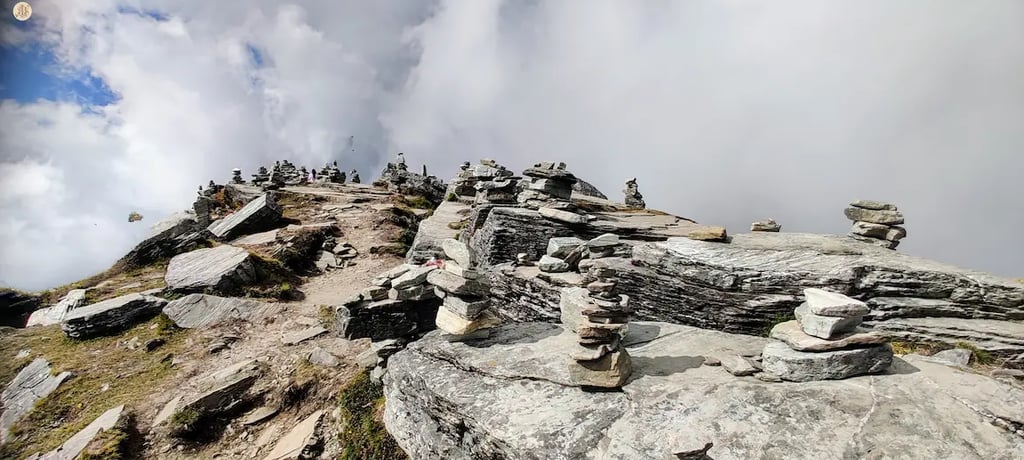

Chandrashila Summit: Touching the Clouds, Embracing the Himalayas
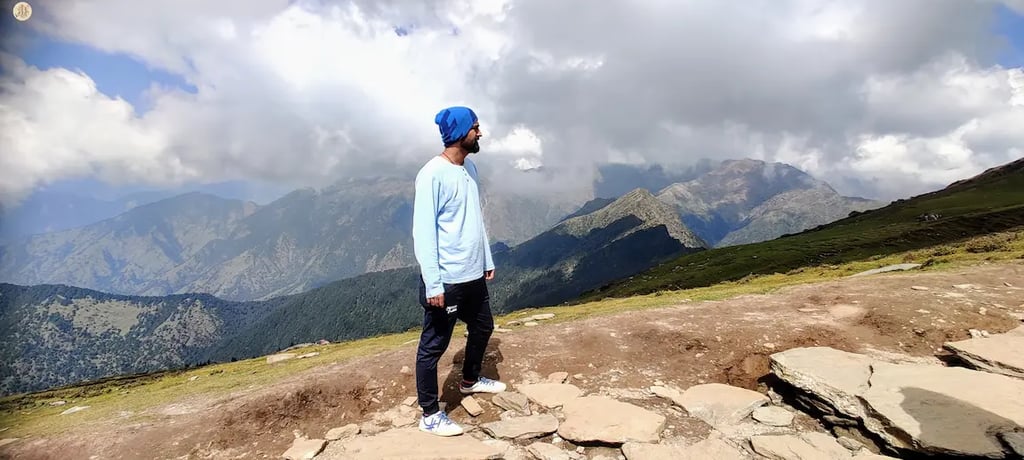

Himalayan Skies: Clouds Dancing Over Majestic Peaks


Chandrashila Summit: Soaring Above, Embracing Himalayan Majesty
Chandrashila Story: Myths, Meditation, and Mountain Magic
Chandrashila, meaning “Moon Rock,” is more than a scenic summit — it is a place steeped in Himalayan mythology and divine tales. According to legend, the Moon God Chandra performing penance at this very summit, giving Chandrashila its celestial name.
Some stories also link Chandrashila to Lord Rama, who is said to have performed deep penance here to atone for Ravana’s death, seeking divine forgiveness and inner purification. This imbues the peak with an aura of penance, reflection, and spiritual awakening, transforming the Chopta–Tungnath–Chandrashila trek into more than a physical journey — it becomes a path of myth, devotion, and transcendence.
Standing atop Chandrashila, trekkers often feel timeless serenity, as if the mountain whispers ancient tales of gods, heroes, and sages. The breathtaking Himalayan panoramas, combined with the summit’s spiritual resonance, make Chandrashila a place where nature, history, and devotion converge, leaving an unforgettable impression on every visitor.
Descent from Tungnath-Chandrashila: Relax and Recharge at Chopta
After absorbing the panoramic views and spiritual energy atop Chandrashila, it’s time to descend carefully back toward Tungnath Temple. Though downhill, the return trek still delights with glimpses of alpine meadows, rhododendron forests, and distant snow-capped Himalayan peaks. Pause often, breathe in the crisp mountain air, and let the serenity of the Garhwal Himalayas seep into your soul.
From Tungnath, continue along the well-paved trail down to Chopta or nearby Sari Village, where your cozy accommodation awaits. A warm meal, a hot shower, and a comfortable room offer the perfect chance to rest and rejuvenate. The tranquil ambiance of Chopta, combined with fresh mountain air, restores both body and spirit, letting you reflect on the day’s trek.
A good rest is essential, as the next day promises a gentle yet rewarding trek to Deoriatal Lake, another jewel of the Garhwal Himalayas. With energy renewed and spirits lifted, you’ll be ready to explore the short, scenic journey to this serene lake, embraced by towering peaks and lush forests.
Day 2 — Deoria Tal Trek & Return Journey
Trek gently to Deoria Tal, where the emerald lake mirrors Chaukhamba and Kedarnath peaks, a serene Himalayan reflection. Descend back to Chopta, then journey through Dhari devi, Rudraprayag and Devprayag, carrying the calm of the mountains and the spirit of adventure home.
Deoria Tal Trek: The Mirror Lake of the Himalayas
After a restful night in Chopta, wake to the call of the mountains and the crisp Himalayan air. A hearty breakfast sets the tone for the day, before you head toward Deoria Tal — also called Devaria or Deoriya Tal. A short drive brings you to Sari Village, the charming hamlet that serves as the base camp for this serene trek.
From Sari, a gentle 2.5 km trail winds uphill through dense rhododendron, oak, and alpine forests. The trek takes about an hour, making it perfect for beginners or anyone seeking a peaceful morning walk amid nature. Birdsong fills the woods, and as you climb, glimpses of distant Himalayan peaks tease through the canopy, hinting at the magical view that awaits above.
Perched at an altitude of around 2,438 meters (7,998 ft) in Uttarakhand’s Rudraprayag district, Deoria Tal is a jewel of the Garhwal Himalayas. The emerald-green lake rests quietly amid lush meadows and forests, perfectly reflecting Chaukhamba’s snow-clad peaks in its still waters. On clear mornings, the mirror-like surface captures Chaukhamba, Bandarpunch, Kalanag, Neelkanth, Kedarnath, and other Himalayan giants, creating a scene that feels almost divine.
For those eager to explore further, the trek can extend to Bisuri Tal, Rohini Bugyal, Chopta, or even loop back toward Tungnath and Chandrashila, forming a scenic circuit of meadows, ridgelines, and forests.
As the sun dips behind the peaks, Deoria Tal glows golden, and the stillness deepens — a moment when the Himalayas whisper their ancient secrets, leaving an imprint of serenity and awe on every visitor.
And if tranquil lakes and rolling meadows call to your heart, don’t miss Mannavanur Lake near Kodaikanal — one of India’s few heart-shaped lakes. Surrounded by vast green pastures and misty hills, it offers mesmerizing vistas that soothe the soul and remind you that nature’s beauty knows no bounds.
Deoria Tal: Mirror of the Majestic Himalayan Peaks
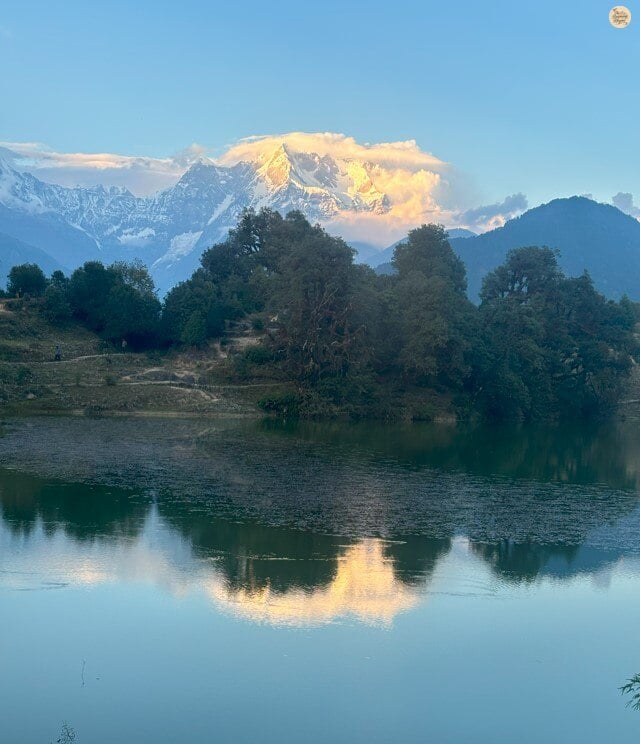

Deoria Tal Story: Myth, Mystery, and Himalayan Serenity
Deoria Tal, often called the Lake of the Gods, is wrapped in myth and mystery, like much of Uttarakhand. Ancient Vedic texts refer to it as Indra Sarovar, where the Devas once descended to bathe, leaving the waters forever sacred. Locals still believe the shimmering lake carries whispers of that divine presence.
The Mahabharata also weaves a tale around this tranquil lake — the famous Yaksha Prashna. During their exile in the Himalayas, the mighty Bheem, thirsty and impatient, came across the lake. Ignoring a mystical warning, he drank its waters and instantly fell unconscious. One by one, his brothers met the same fate — until Yudhishthir, the eldest, arrived. Humble and wise, he answered the riddles posed by the mystical Yaksha before drinking, reviving his brothers and proving that patience and wisdom triumph over haste. Many believe Deoria Tal is the very lake where this legend unfolded.
Another local tale whispers that Bheem himself carved the lake, guided by Yudhishthir’s calm foresight, quenching his thirst under the Himalayan skies. Even today, villagers speak of the lake’s divine origins with quiet reverence — a place where gods once rested, where lessons of wisdom and humility were etched into the serene Himalayan landscape.
Stopover at Dhari Devi: Guardian of the Himalayan Hills
On your return journey from Deoria Tal to Rishikesh, pause for a soulful stop at Dhari Devi Temple, gracefully perched on the banks of the Alaknanda River between Srinagar and Rudraprayag. This ancient shrine, believed to be over 600 years old, is one of Uttarakhand’s most revered spiritual sites. Once directly in the river, the temple now rests on a raised platform, preserving its sanctity amidst the flow of time and tide.
The temple is dedicated to Goddess Dhari, a fierce yet protective form of Goddess Kali, regarded as the guardian of the Char Dham pilgrimage sites — Badrinath, Kedarnath, Gangotri, and Yamunotri. Interestingly, only the upper half of the goddess’s idol is enshrined here, while the lower half resides in Kalimath, symbolizing the balance of creation and destruction — a divine harmony that defines her power.
Devotees also believe the idol transforms throughout the day, appearing as a young girl in the morning, a woman at noon, and an elderly lady by evening, reflecting the eternal cycle of life and nature.
Counted among India’s 108 Shakti Sthals as mentioned in the Srimad Devi Bhagwat Purana, Dhari Devi’s legend stretches back to the Dwapar Yuga, when divine energies were said to manifest on Earth to protect the land. A stop here is not just a pause in your journey, but a moment to connect with centuries of devotion, Himalayan mysticism, and the protective grace of the guardian of the hills.
If you feel drawn to explore more divine manifestations of the Goddess, you can also visit Shakambhari Devi Temple — another sacred incarnation of Goddess Durga. Nestled on a hillock near the shimmering Sambhar Salt Lake, this temple carries its own aura of serenity and power, reminding devotees of the nurturing yet formidable spirit of the Divine Mother.
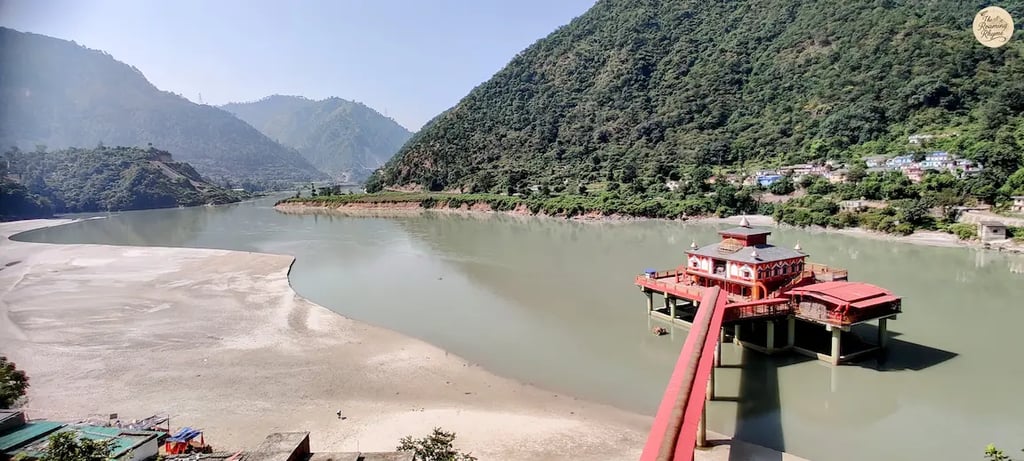

Dhari Devi Temple: The Guardian of Alaknanda’s Flow
Dhari Devi Story: Guardian of the Char Dham Pilgrimage
According to local lore, centuries ago, the idol of Dhari Devi was swept away by floods and lodged between rocks near Dhari Village. That night, a villager dreamt of the goddess instructing him to retrieve the idol and place it exactly where it had been found, under the open sky. The villagers obeyed, and from that day, Dhari Devi Temple became a symbol of divine presence and protection — an open-air sanctuary where the goddess watches over the hills, rivers, and travelers.
Priests and devotees say her changing appearance mirrors her moods — calm, powerful, or fierce — depending on the time of day. Many also believe the well-being of the region is tied to her peace. This belief was strengthened after June 16, 2013, when the idol was moved to a higher concrete platform to make way for the Alaknanda Hydroelectric Project. Mere hours after the relocation, devastating floods and landslides struck Kedarnath and nearby towns, deepening the local conviction that disturbing the goddess’s original abode, her Mool Sthan, invites the wrath of nature.
Whether you pause here for a quick darshan or linger by the rushing Alaknanda River, Dhari Devi Temple leaves a lasting impression — of divinity, mystery, and the untamed spirit of the Himalayas. It is not just a temple, but a guardian’s gaze, watching over every pilgrim, every trail, and every story woven into these sacred mountains.
From Dhari Devi, continue your return journey toward Rishikesh, winding through Rudraprayag and Devprayag — two sacred confluences where rivers meet in graceful harmony. As the mountains recede, the tranquil river vistas and winding Himalayan roads gradually give way to the bustling plains below.
Eventually, you reach Rishikesh, where your Chopta–Tungnath–Chandrashila–Deoria Tal trek comes full circle. From here, your journey continues homeward, carrying with you memories of serene alpine trails, sacred temples, and the timeless rhythm of the Garhwal Himalayas — moments that linger long after the mountains fade from view.
As your Himalayan adventure winds down, you carry more than just photographs — you carry the calm of Tungnath Temple’s bells, the thrill of Chandrashila’s sunrise, and the mirror-like stillness of Deoria Tal. Each step of this journey — from Rishikesh’s riverbanks to Chopta’s alpine meadows — is a quiet act of tracing the path unknown, where devotion, discovery, and reflection blend seamlessly into the roaming rhyme of the mountains.
Whether you sought spiritual solace or the call of the peaks, the Chopta–Tungnath–Chandrashila–Deoria Tal trek leaves a lasting impression. The trek may be short, but its impact endures — a perfect harmony of nature, legend, and peace.
Before returning, pause at Dhari Devi Temple on the Alaknanda River — a gentle farewell from the hills themselves. From here, the road winds back toward Rishikesh, completing the circle between faith, adventure, and the serenity of the Garhwal Himalayas.
When you plan your next escape, remember this magical corner of Uttarakhand, where every trail tells a story, every peak whispers a prayer, and every traveler finds a piece of calm to take home — a living roaming rhyme, echoing the beauty of tracing the path unknown.
Frequently Asked Questions – Tungnath-Chandrashila Trek Guide
Q. How long is the Tungnath Trek?
A. The Tungnath trek is about 3.5 km one way from Chopta and takes 2–3 hours to climb at an easy pace. The trail is well-paved and beginner-friendly, with mesmerizing Himalayan views guiding every step.
Q. Is Tungnath Trek difficult?
A. Not at all — the Tungnath trek is moderate and suitable for beginners. The path is steady, with stone steps and resting spots along the way. It’s less about struggle, more about soaking in the rhythm of the mountains.
Q. What is Tungnath famous for?
A. Tungnath is the world’s highest Shiva temple, a sacred gem of the Panch Kedar. It’s celebrated for its divine aura, ancient legends, and breathtaking views of Chaukhamba, Trishul, and Nanda Devi — where faith meets the sky.
Q. Can I go to Tungnath from Kedarnath?
A. Yes, though not directly. You can travel from Kedarnath to Chopta via Ukhimath, and then trek to Tungnath. It’s a journey that beautifully connects two of Lord Shiva’s most revered abodes in the Garhwal Himalayas.
Q. Can we visit Tungnath by car?
A. Cars can go only up to Chopta, the base point of the trek. From there, the rest of the way to Tungnath must be covered on foot or by pony, letting you truly feel the calm and charm of the trail.
Q. Is there an oxygen problem at Tungnath?
A. While Tungnath sits at around 12,100 feet, most trekkers face no major oxygen issues. Just walk at your own pace, stay hydrated, and pause often — the mountains reward those who move with ease.
Q. Can Tungnath trek be done alone?
A. Absolutely. The trail is safe, well-marked, and friendly, with fellow trekkers and locals often on the route. Solo travelers often find Tungnath’s peace and solitude deeply rejuvenating — a journey within as much as beyond.
Q. Is Amarnath higher than Tungnath?
A. Yes. The Amarnath Cave sits at about 12,700 feet, slightly higher than Tungnath (12,100 feet). But both hold their own divine grace — one wrapped in ice, the other crowned by meadows and mountains.
Q. In which month does Tungnath Temple close?
A. The Tungnath Temple closes in November every year as winter sets in. The idols are then moved to Ukhimath, where prayers continue until the temple reopens around April or May.
Q. Is there snowfall in Tungnath?
A. Yes, Tungnath receives heavy snowfall from December to March. The temple remains closed during this time, but the snow turns Chopta into a white wonderland, perfect for winter trekking and photography.
Share Your Thoughts – We’d Love to Hear From You!
Every journey is better when shared.
We hope you enjoyed this travel story — now, we'd love to hear yours! Share your experience, suggestions, or feedback and help us make our travel tales even better.
